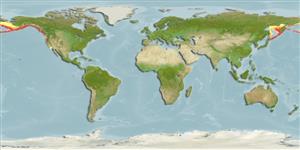Classification / Names
Common names from other countries
Main reference
Size / Weight / Age
Max length : 53.0 cm TL male/unsexed; (Ref. 56527); max. published weight: 2.1 kg (Ref. 56527); max. reported age: 103 years (Ref. 93933)
Length at first maturity
Lm 33.1, range 25 - 43.3 cm
Environment
Marine; bathydemersal; depth range 0 - 825 m (Ref. 6793), usually 165 - 293 m (Ref. 27437)
Climate / Range
Deep-water, preferred 6°C (Ref. 107945); 64°N - 24°N, 143°E - 110°W (Ref. 54884)
Distribution
North Pacific: Honshu, Japan to Cape Navarin in the Bering Sea (but not in the Sea of Okhotsk) and La Jolla, California, and along the Aleutians from Stalemate Bank and Bowers Bank to the Alaska Peninsula. Stocks have suffered severe population decline due to overfishing (Ref. 27437).
Countries | FAO areas | Ecosystems | Occurrences | Introductions
Short description
Dorsal
spines
(total): 13;
Dorsal
soft rays
(total): 14-17;
Anal
spines: 3;
Anal
soft rays: 6 - 9;
Vertebrae: 26. Head spines weak - nasal, preocular, supraocular (may be absent), postocular, tympanic, parietal, and nuchal (may be absent) spines present, coronal spine absent (Ref. 27437). Long lower jaw with prominent forward directed symphyseal knob (Ref. 27437). Posterior margin of caudal indented (Ref. 6885). Bright to light red, usually with dark markings dorsally, may have some dark stippling on sides and dark blotch on caudal peduncle (Ref. 27437).
IUCN Red List Status (Ref. 115185)
Threat to humans
Harmless
Human uses
Fisheries: highly commercial; gamefish: yes
Tools
Special reports
Download XML
Internet sources
Estimates of some properties based on models
Phylogenetic diversity index
PD50 = 0.5000 many relatives (e.g. carps) 0.5 - 2.0 few relatives (e.g. lungfishes)
Trophic Level
3.5 ±0.3 se; Based on diet studies.
Resilience
Very Low, minimum population doubling time more than 14 years (Musick et al. 2000 (Ref. 36717); tmax=103; tm=7; K=0.1; Fec=31,000)
Vulnerability
High vulnerability (55 of 100)
Price category
